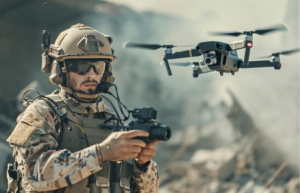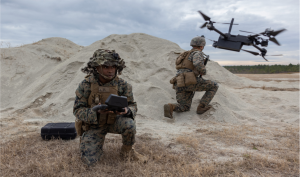 As modern warfare becomes increasingly technology-driven, the integration of small drones, or Unmanned Aerial Systems (UAS), into military operations has significantly transformed defense strategies worldwide. Small drones offer powerful capabilities that enhance situational awareness, provide precision strikes, and reduce risks to personnel. The increasing reliance on small drones by even the largest militaries underscores their role in shaping the future of combat and intelligence operations. However, despite their advantages, several challenges must be addressed to ensure these systems reach their full potential in military settings. This article explores the advantages of small drones for large militaries and the challenges that must be overcome to maximize their effectiveness.
As modern warfare becomes increasingly technology-driven, the integration of small drones, or Unmanned Aerial Systems (UAS), into military operations has significantly transformed defense strategies worldwide. Small drones offer powerful capabilities that enhance situational awareness, provide precision strikes, and reduce risks to personnel. The increasing reliance on small drones by even the largest militaries underscores their role in shaping the future of combat and intelligence operations. However, despite their advantages, several challenges must be addressed to ensure these systems reach their full potential in military settings. This article explores the advantages of small drones for large militaries and the challenges that must be overcome to maximize their effectiveness.
- The Strategic Advantage of Small Drones
Small drones have proven to be highly effective tools for modern militaries, offering several strategic advantages that are critical in current and future military operations.
Key Benefits:
Enhanced Intelligence, Surveillance, and Reconnaissance (ISR): Small drones enable real-time collection of intelligence from the battlefield, providing military personnel with valuable insights that inform decision-making. Their ability to fly at lower altitudes and access hard-to-reach areas makes them invaluable for surveillance and reconnaissance missions. The miniaturization of cameras and sensors allows for detailed imagery and precise monitoring of enemy movements.
Cost-Effectiveness: Compared to traditional manned aircraft or satellites, small drones are relatively inexpensive to manufacture, maintain, and operate. This makes them a highly cost-effective solution for performing tasks that would otherwise require expensive, larger platforms. Their affordability also allows for mass deployment, providing a swarm-like effect to overwhelm enemy defenses or surveil large areas.
Quick Deployment and Mobility: Small drones are highly portable and can be rapidly deployed in various environments, including urban areas, remote terrains, and hostile zones. Their compact size allows them to be easily transported by soldiers or launched from vehicles, enhancing mobility and operational flexibility. The ability to quickly launch drones for short-term reconnaissance or tactical advantage is invaluable in dynamic combat scenarios.
Minimized Risk to Personnel: Small drones provide a significant reduction in the risk to personnel during reconnaissance, surveillance, or airstrike missions. This is particularly advantageous in high-risk environments, as unmanned systems can enter hostile territories, scout enemy positions, or deliver payloads without putting soldiers in direct danger.
- Applications of Small Drones in Military Operations
Militaries around the world have already begun leveraging small drones for a variety of tasks, and their roles continue to evolve as technology advances.
Key Applications:
Precision Strike Capability: Small drones, especially those equipped with miniature weapons systems, can be used for targeted strikes on enemy positions, equipment, or personnel. These drones enable high-precision strikes with minimal collateral damage, ensuring that military objectives are achieved with a high degree of accuracy.
Electronic Warfare and Jamming: Small drones can be equipped with electronic warfare capabilities to disrupt enemy communication and surveillance systems. By deploying drones that can jam signals, intercept communications, or carry out cyberattacks, militaries can gain a strategic edge in electronic warfare, disrupting enemy operations and gaining intelligence.
Search and Rescue Operations: Drones can be used in search and rescue missions to locate and evacuate injured personnel, particularly in hostile or hard-to-reach environments. By using small drones equipped with thermal imaging cameras or sensors, militaries can quickly pinpoint survivors and coordinate rescue operations, potentially saving lives.
Logistical Support and Resupply: Small drones can also be deployed for tactical resupply operations, delivering ammunition, medical supplies, food, or equipment to front-line troops. This reduces the need for traditional resupply routes, which can be vulnerable to enemy attacks, and enhances logistical efficiency in conflict zones.
Surveillance in Urban Warfare: In urban combat environments, where traditional ISR platforms may face limitations, small drones excel due to their size and ability to navigate complex environments. They can fly through tight spaces, such as alleyways, buildings, and urban infrastructure, providing critical surveillance in dense environments while minimizing the risk to human assets.
- Challenges and Limitations of Small Drones for Military Use
Despite the many advantages small drones bring to military operations, several challenges must be addressed to optimize their effectiveness in combat and intelligence-gathering scenarios.
Key Challenges:
Battery Life and Endurance: One of the primary limitations of small drones is their relatively short battery life, which limits their operational range and flight time. While advances in battery technology and power management are making strides, the need for longer operational endurance remains a critical challenge for military use, especially in long-duration reconnaissance or strike missions.
 Security and Anti-Jamming Measures: Small drones are vulnerable to cyberattacks, signal jamming, or hacking, which can compromise their mission or even turn them against their operators. Securing communication channels, encrypting data transmission, and implementing anti-jamming technology are essential to mitigate these risks. Militaries must also develop countermeasures to protect against enemy drones that may attempt to interfere with operations.
Security and Anti-Jamming Measures: Small drones are vulnerable to cyberattacks, signal jamming, or hacking, which can compromise their mission or even turn them against their operators. Securing communication channels, encrypting data transmission, and implementing anti-jamming technology are essential to mitigate these risks. Militaries must also develop countermeasures to protect against enemy drones that may attempt to interfere with operations.
Airspace Management: With the proliferation of drones in military operations, managing airspace becomes increasingly complicated. Militaries need effective airspace management systems to prevent drone collisions and ensure that multiple drones can operate simultaneously without interfering with manned aircraft or other systems. This requires the development of advanced air traffic management systems, especially in complex environments like urban warfare.
 Targeting and Tracking in Challenging Environments: Small drones face difficulties when operating in environments with limited visibility or under conditions that may obstruct GPS signals, such as dense urban areas, forests, or underground facilities. To overcome this, advancements in autonomous navigation, computer vision, and AI-based tracking are needed to enable small drones to function in GPS-denied or cluttered environments.
Targeting and Tracking in Challenging Environments: Small drones face difficulties when operating in environments with limited visibility or under conditions that may obstruct GPS signals, such as dense urban areas, forests, or underground facilities. To overcome this, advancements in autonomous navigation, computer vision, and AI-based tracking are needed to enable small drones to function in GPS-denied or cluttered environments.
Regulatory and Ethical Concerns: The increasing use of small drones, especially in combat and surveillance, raises significant ethical and regulatory concerns. The deployment of autonomous systems for targeted killings or surveillance can lead to questions regarding accountability, privacy, and the rules of engagement. International treaties and agreements will need to address these concerns and provide frameworks for responsible drone use in warfare.
- The Future of Small Drones in Military Operations
The future of small drones in military operations looks promising, driven by continuous innovation in technology and evolving military strategies.
Future Developments:
Swarming and Coordination: The use of drone swarms—multiple small drones operating in coordinated groups—will likely become a key feature of future military tactics. These swarms can overwhelm enemy defenses, conduct synchronized strikes, or provide more extensive coverage in reconnaissance missions. Advances in swarm intelligence and AI will allow small drones to operate autonomously in large numbers, collaborating seamlessly to achieve tactical objectives.
Autonomous Decision-Making: As AI technologies evolve, the autonomous capabilities of small drones will continue to improve. Future drones may have enhanced decision-making abilities, enabling them to assess real-time data, engage targets, and adjust flight paths without human intervention. This could significantly reduce response times and increase operational efficiency.
Advanced Payloads and Multi-Role Functions: Future small drones will be equipped with more advanced sensors, weapons systems, and multi-functional payloads that enable them to perform a broader range of tasks in complex environments. The integration of advanced imaging systems, chemical detection sensors, and even non-lethal weapons could diversify the roles of small drones in military operations.
Conclusion
Small drones have revolutionized modern military operations, providing capabilities that enhance situational awareness, precision strikes, and overall mission success while minimizing risks to personnel. Despite challenges like limited battery life, cybersecurity vulnerabilities, and complex airspace management, continued technological advancements and strategic developments will enable these systems to play an even more significant role in future warfare. As small drones evolve, their integration into military strategies will increase, ultimately shaping the future of defense operations with greater efficiency, autonomy, and precision. With a focused approach to innovation and adaptation, small drones will continue to be a powerful tool for militaries seeking to maintain a technological edge in modern combat.























































